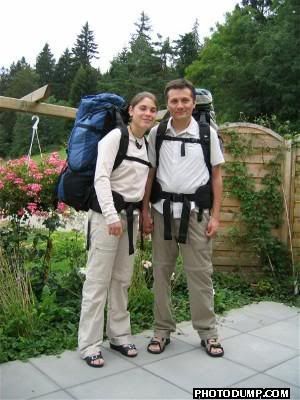Tuesday, February 08, 2005
Thailand: In the heart of Lanna
After exploring its western fringes, we moved into the heart of the former Lanna kingdom. The route we followed took us through Chiang Mai, Lampang, Phrae, Nan and Chiang Rai.
Some history
The northern Thai kingdom of Lanna was founded at the same time as Sukothai. In 1292, after unifying the squabbling Thai and Mon principalities of the region, King Mengrai selected the site of Chiang Mai on the Ping river for his new capital. Lanna experienced a golden age in the 14-15th centuries. But, under continuing pressure from both Ayutthaya and Burma, it got into rapid decline soon after. In 1558, after a short period under Laos, it got invaded by Burma who controlled it for over 200 years through a succession of puppet rulers.
With the help of Bangkok, Lanna eventually managed to liberate itself. But, though it kept its own separate monarchy, it became a vassal state of Siam... From the 2nd half of the 19th century, the Siamese rulers and the powerful logging industry made efforts to integrate Lanna by building roads, railway and telegraph lines. In the 1930s, with the end of the absolute monarchy in Thailand, Lanna got a governor and became a fully integrated province.
Nowadays, Lanna's heritage can best be appreciated in religious art and architecture. The Buddahs are stockier and have thicker features than in central Thailand. The temples typically have low eves and often bear a double arch "eyebrow" structure over the main entrance:
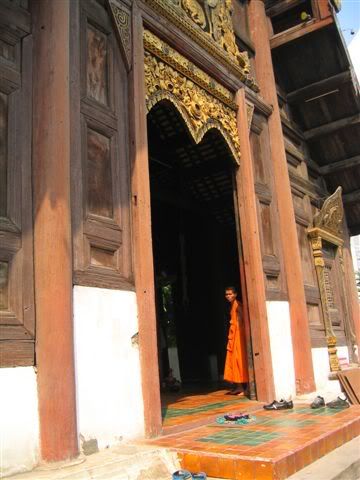
Particularities can also be spotted in housing, cooking and language... A Lanna style house in Lampang with its distinctive crosses on the roofs:
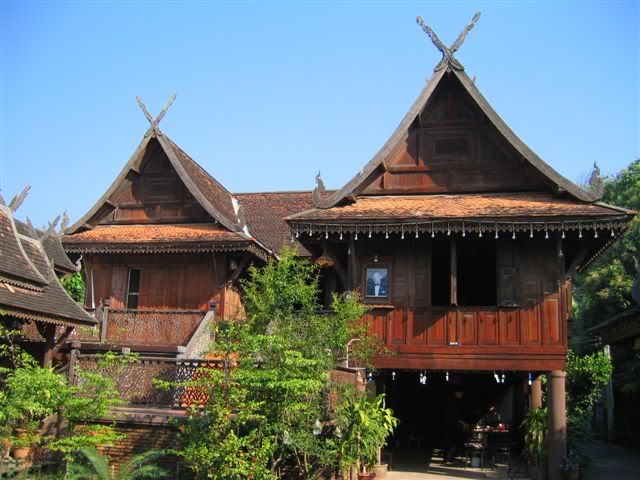
Our trip
We started our journey with Chiang Mai, where we stayed 2 weeks. Before rushing to the cultural attractions, we booked a 5 days traditional thai massage course (the sort tought and practised in temples, not in red light districts!), from which we graduated with softened muscles, healthier and more zen than ever!

Beside some fine temples, Chiang Mai has an excellent hill tribe museum and some nice and shady ruins of an ancient Mon city on its outskirts at Wiang Kum Kam (which make an excellent bicycle day trip!):
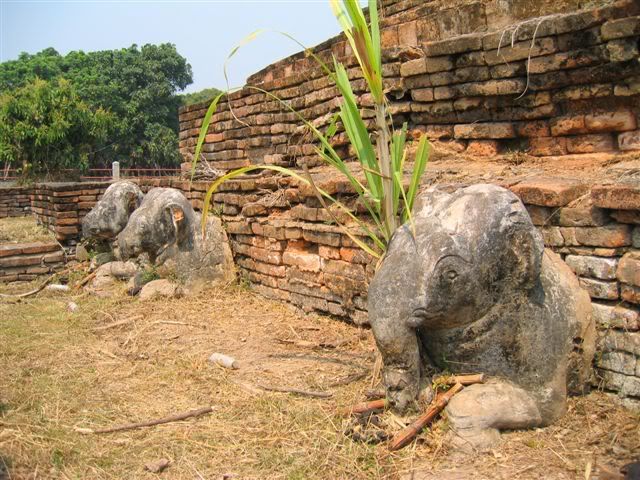
...the famous Wat Phra Singh, a 14th century temple:

20 km south of Chiang Mai, the Saturday morning buffalo market at Santpatong was probably one of our most memorable experience. A exhilarating exhibition of beautiful bovine specimens and their proud owners in a friendly rural atmosphere:
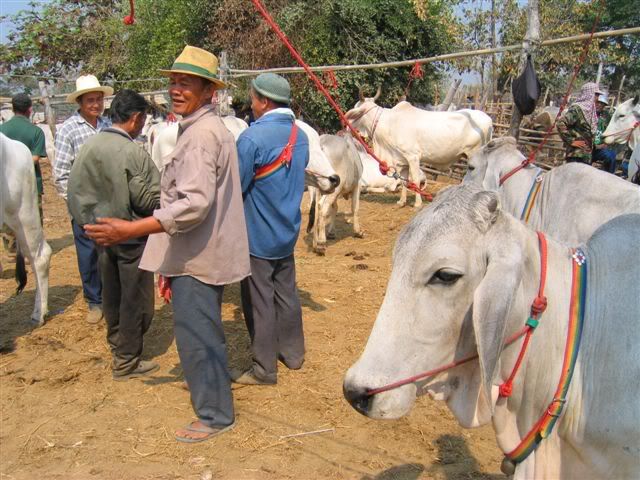
Lampang, 100 km southeast, was a nice place to stop. Unlike Chiang Mai, it kept a feeling from the past with its traditional wooden houses (see picture above). Wat Phrae That Lampang Luang, 10 km out of town, was probably the most beautiful temple we saw in Thailand. Authentic and not afraid of showing its age in its copper and wooden structures, it had a great atmosphere!

Further west, the city of Phrae and its traditional houses also had this sedate charm.
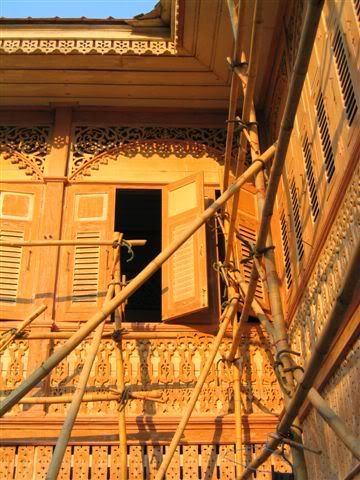
The province of Nan was even more quiet and remote. The people lazily starting getting up for work at 9 o'clock, at usually closed their shops at 17h00. In the 1970s, the area even tried to break off from Thailand when communist idealists declared Nan the capital of a liberated zone. They only succeeded in bringing the full might of the Thai army on them and a strong military presence can still be felt today.
Other from this, Nan is known for the 19th century murals in a couple of its temples:

At Sao Din, a site 60km of south of Nan best reached by motorbike, centuries of soil erosion by wind and water formed an intriguing scenery of earth pillars:
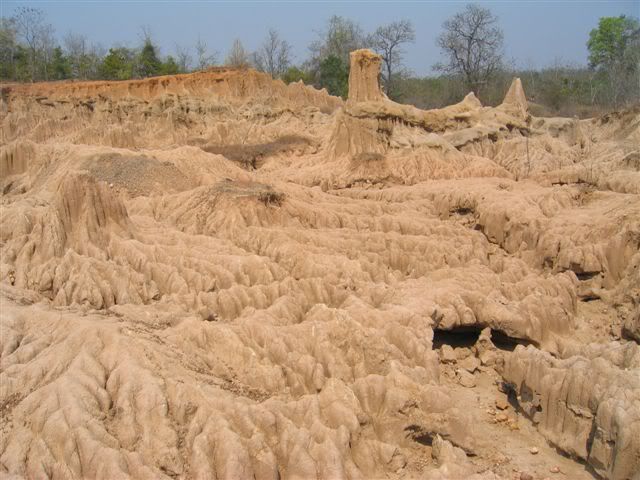
At the end of this journey, the city of Chiang Rai was quite unspectacular. But it was a good point to rest for a night and get ready for Laos...
Some history
The northern Thai kingdom of Lanna was founded at the same time as Sukothai. In 1292, after unifying the squabbling Thai and Mon principalities of the region, King Mengrai selected the site of Chiang Mai on the Ping river for his new capital. Lanna experienced a golden age in the 14-15th centuries. But, under continuing pressure from both Ayutthaya and Burma, it got into rapid decline soon after. In 1558, after a short period under Laos, it got invaded by Burma who controlled it for over 200 years through a succession of puppet rulers.
With the help of Bangkok, Lanna eventually managed to liberate itself. But, though it kept its own separate monarchy, it became a vassal state of Siam... From the 2nd half of the 19th century, the Siamese rulers and the powerful logging industry made efforts to integrate Lanna by building roads, railway and telegraph lines. In the 1930s, with the end of the absolute monarchy in Thailand, Lanna got a governor and became a fully integrated province.
Nowadays, Lanna's heritage can best be appreciated in religious art and architecture. The Buddahs are stockier and have thicker features than in central Thailand. The temples typically have low eves and often bear a double arch "eyebrow" structure over the main entrance:

Particularities can also be spotted in housing, cooking and language... A Lanna style house in Lampang with its distinctive crosses on the roofs:

Our trip
We started our journey with Chiang Mai, where we stayed 2 weeks. Before rushing to the cultural attractions, we booked a 5 days traditional thai massage course (the sort tought and practised in temples, not in red light districts!), from which we graduated with softened muscles, healthier and more zen than ever!

Beside some fine temples, Chiang Mai has an excellent hill tribe museum and some nice and shady ruins of an ancient Mon city on its outskirts at Wiang Kum Kam (which make an excellent bicycle day trip!):

...the famous Wat Phra Singh, a 14th century temple:

20 km south of Chiang Mai, the Saturday morning buffalo market at Santpatong was probably one of our most memorable experience. A exhilarating exhibition of beautiful bovine specimens and their proud owners in a friendly rural atmosphere:

Lampang, 100 km southeast, was a nice place to stop. Unlike Chiang Mai, it kept a feeling from the past with its traditional wooden houses (see picture above). Wat Phrae That Lampang Luang, 10 km out of town, was probably the most beautiful temple we saw in Thailand. Authentic and not afraid of showing its age in its copper and wooden structures, it had a great atmosphere!

Further west, the city of Phrae and its traditional houses also had this sedate charm.

The province of Nan was even more quiet and remote. The people lazily starting getting up for work at 9 o'clock, at usually closed their shops at 17h00. In the 1970s, the area even tried to break off from Thailand when communist idealists declared Nan the capital of a liberated zone. They only succeeded in bringing the full might of the Thai army on them and a strong military presence can still be felt today.
Other from this, Nan is known for the 19th century murals in a couple of its temples:

At Sao Din, a site 60km of south of Nan best reached by motorbike, centuries of soil erosion by wind and water formed an intriguing scenery of earth pillars:

At the end of this journey, the city of Chiang Rai was quite unspectacular. But it was a good point to rest for a night and get ready for Laos...
